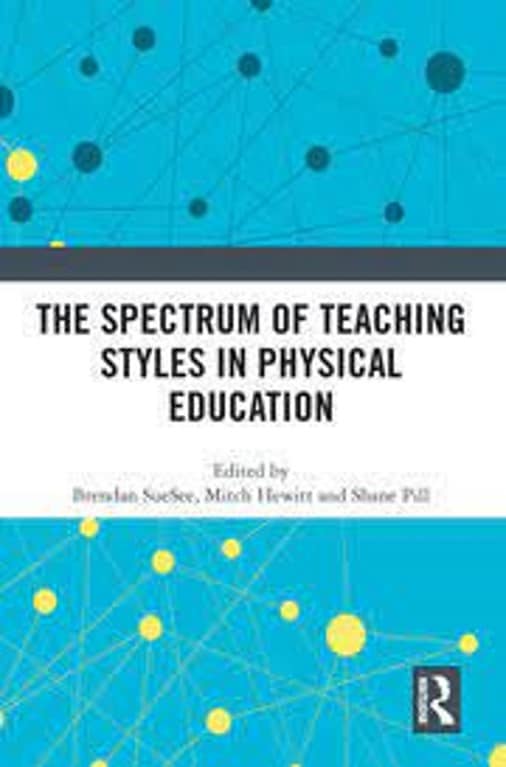
Introduction
This book by SueSee, Hewitt and Pill published by Routledge in March 2020, is a welcomed in-depth exploration of the spectrum of teaching styles in PE, that was first proposed by Muska Mosston in 1966. SueSee, Hewitt and Pill (2020) provide a practice-focused lens to help practitioners apply the spectrum of teaching styles in practice, for anyone new to the idea, this helpful summary of teaching styles A-K was created and published by Dr Joe Scott in July 2022 and is well worth a look before we dig into the book review.
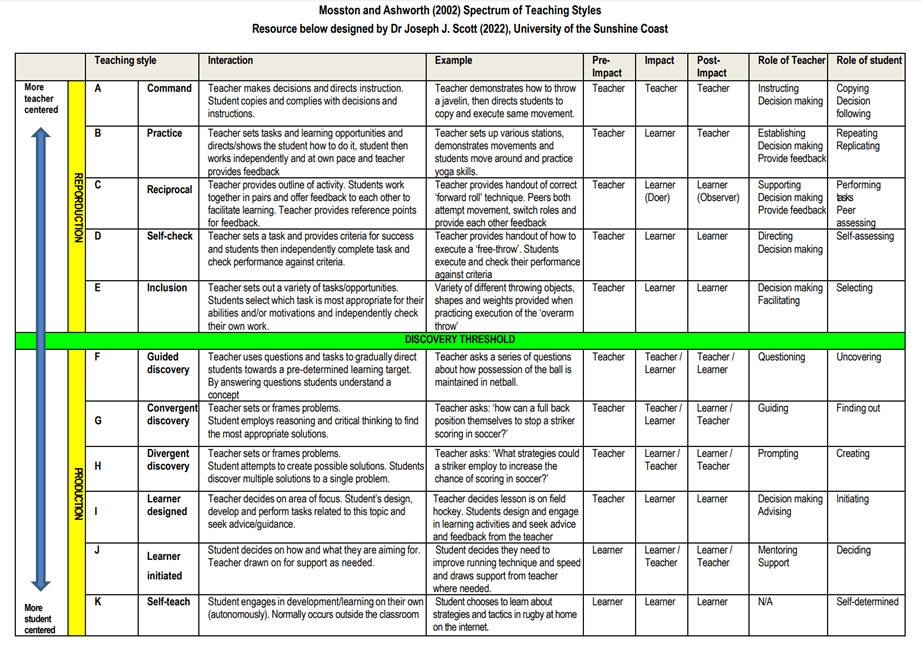
SueSee, Hewitt and Pill (2020) do a great job of describing the history of ‘spectrum theory’, providing real-world examples from school and university settings and considering the significance in areas like PE Teacher Education (PETE), sport pedagogy and models-based practice (e.g. Teaching Games for Understanding and Game Sense). It is aimed at PE teachers (pre-service and more experienced), teacher educators and sports coaches to help make use of ‘The Spectrum’.
We will take a whistle stop tour through the book stopping at and summarising the following sections:
- A brief history and overview of The Spectrum
- Use of The Spectrum in PE, PETE and how it can promote holistic development
- Inclusion Style unpicked
- Reciprocal Style in action
- Future considerations on ‘The Spectrum’
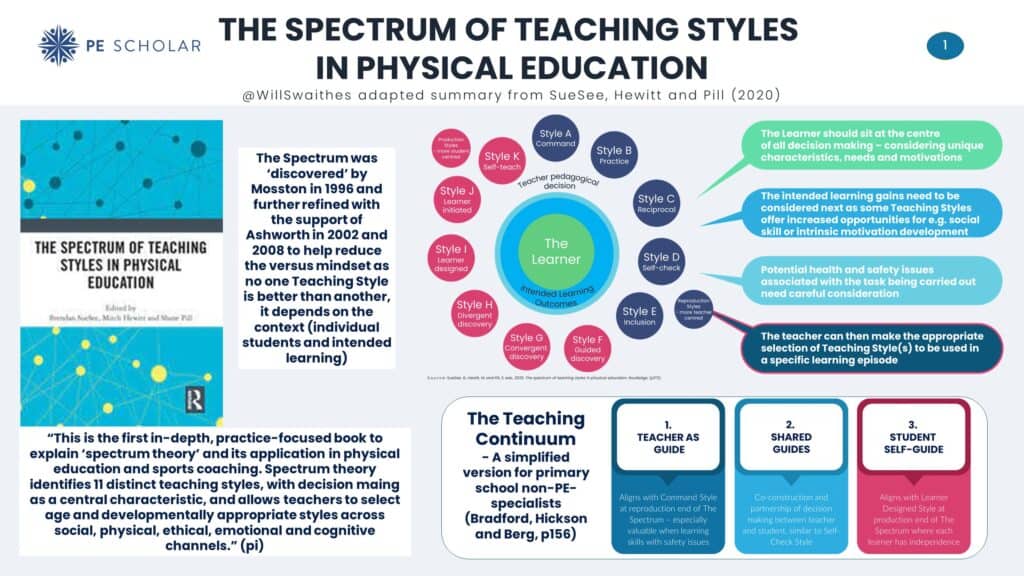
A brief history and overview of The Spectrum
The Spectrum was not created by Mosston in 1966, in the same way gravity was not created by Newton, but it was discovered (p2). He was exploring the overlap between concepts from psychology, cognitive psychology, motor learning and education to suggest that there is not one best way to teach PE but instead different approaches that are dependent on different circumstances. Mosston searched hard ‘for the answer to “what is the body of knowledge about teaching that is beyond idiosyncratic behaviour?”’ (p2). He was eager to clarify language and create a simple framework based on the level of decision making and behaviour provided by the teacher versus the student in lessons. So, debating the importance of teacher professional judgement to match style of teaching to learning objectives has been a rich conversation for at least 50 years. The idea of paint by numbers or strict adherence to a generic lesson plan or rubric for outstanding learning in all situations is absolute rubbish regardless of what some key stakeholders might like us to believe.
The idea of teachers exploring The Spectrum alongside their students and handing over increased control, responsibility and independence for decision making in lessons is definitely one that has worked for me. Taking learners on a journey from command to discovery and beyond is all part of the rich tapestry of teaching and adapting to the specific needs of the group based on ability, activity, environment, needs, task, motivations and much more. In the same way that Bloom never intended his taxonomy to suggest a hierarchy of evaluation being harder or more valuable than knowledge, the suggestion is that a dance is performed up and down The Spectrum to provide rich and varied learning opportunities.
50 years ago Mosston was concerned about the dominance of Command Style (p4) and I wonder if much has changed to today? SueSee et al., (2020) argue that no style is more valuable than another, it is merely a continuum of approaches that have more or less teacher versus student ownership of decision making.
The Spectrum was revised in 2002 and again in 2008 to help reduce the versus mindset – to help bust the myth that one style is better than another and instead help practitioners recognise the need to select the best approach based on the desired objectives (p6). Various abridged versions of The Spectrum have been produced by other academics over the years, for example Kirk and colleagues reduced the 11 teaching styles to just five (p10) and some authors prefer the term methods to styles.
A brief description of some of the ‘Landmark Styles (A-K) is provided by Sara Ashworth in Chapter 2 and can be summarised as follows:
| A | Command Style | The teacher makes all the decisions (e.g. a marching band as all members dress, move and play music to the direct instructions of the leader). It is not inherently good or bad but instead there is a time and place for its use. |
| B | Practice Style | ‘The teacher decides on the task(s) to be learned and on the criteria of acceptable performance, but the learner decides the set of nine decisions (i.e.. location, order, starting time, pace, interval etc) during practice’ (p17). |
| C | Reciprocal Style | Learners are paired up during practice to get feedback from a partner (i.e. the doer and the observer). |
| D | Self-check Style | Learners self-assess based on criteria provided by the teacher. |
| E-J | Shift in characteristics from reproduction (whereby the learner engages their memory for recall or replication) through to production (whereby learners engage in discovery of information that was previously unknown to them). | |
| K | Self-teach Style | Learners make all the decisions before, during and after performance. They must be self-motivated to work independently and set appropriate goals and practice conditions. |
The idea of teaching episodes is explored on page 20 to help with planning teaching and learning with a focus on the task and style. An episode may last a few minutes or continue over multiple lessons both of which are completely okay.
Use of The Spectrum in PE, PETE and how it can promote holistic development
Chapter 4 makes a strong case for a common language and consistent use of terminology. Mosston’s Command Style carries significant similarities to Metzler’s Direction Instruction method and perhaps we are getting too caught up in nuance or preferred framework rather than focusing time on improved selection of the appropriate teaching style based on the learning objectives sought? As many policy documents and syllabus goals reference the desire to develop problem solvers, independent enquirers, creative thinkers and a whole host of other student characteristics, SueSee suggests it would be helpful to analyse the time spent utilising the different Landmark Styles in practice to help shed light on the likelihood of such characteristics actually being enhanced.
Pill and Rankin explore the merit of The Spectrum to underpin PETE in Chapter 5, suggesting that the deliberate use of it to model, practice, observe and reflect on a common language framework is a helpful way to prepare effective teachers.
In Chapter 6 Hewitt reflects on the prevalence in use of Practice Style in coaching tennis in Australia before exploring other examples, such as Divergent Discovery Style for its potential in developing problem solvers who are more able to outwit their opponent in a game situation. Questions like “How can you set up an attack and win the point from the net?” (p64) clearly have significant value in developing more competent performers when compared with exclusive use of the skill-drill style of repeated practice. A number of other Landmark Styles are described in practice within tennis to support the physical, cognitive, emotional and social domains of learning. There is clearly a strong case for careful consideration of Teaching Styles in sports coaching as well as in PE.
The popularity of constraints-led approaches (CLA) to coaching, motor learning and PE are discussed further in Chapter 7. Two specific examples of learning episodes are then unpicked to place them on The Spectrum. ‘It does not pit The Spectrum against CLA. Rather, it demonstrates the value of The Spectrum as a lens through which teachers, mentors and teacher educators may view the complexity of any teaching (or coaching) approach’ (p73). For me this has been the most helpful chapter as it helps demystify the similarities, differences, challenges and opportunities around use of The Spectrum and models such as CLA. It includes a thorough explanation of how constraints can help manipulate learners towards desired decision making and exploration of possibilities to overcome problems in terms of motor behaviour rather than simple information processing. When implemented well, the CLA, Game Sense or TGfU require ‘deliberate use of astute questions by teachers to create a “guided discovery” style of teaching’ (p77). This chapter also explores the complexities and requirement for significant knowledge of the activity if teachers are to take learners across the ‘discovery threshold’ and develop true ‘thinking players’.
Inclusion Style unpicked
Chapter 10 unpicks the Inclusion Style by explaining what it may look like in practice using a batting lesson example and how that relates to physical, cognitive and affective domains of learning. In this style, students make decisions about:
- Pace
- Location
- Start and stop times
- Level of difficulty
Students also self-assess with the help of a task sheet. The advantages of this style are that students are empowered to operate within their own struggle zone which works well for a mixed ability class as it gives students autonomy and responsibility for their own learning. This student-centred instructional approach typically aids motivation (p107). The batting lesson described includes performance cues and a scoring grid to aid self-assessment. When using Inclusion Style for the first time with a class it is recommended to ease them in gently to increased autonomy, for example starting by just giving choice on level of difficulty before introducing the self-assessment task is considered good practice. It is clear from the example that the Inclusion Style offers great opportunities to maximise development of cognitive, social and psychological development as well as physical skill practice.
Reciprocal Style in action
Chapter 11 presents some new research on the Reciprocal Style from the perspective of multiple syllabus documents from around the world. SHAPE America includes goals around social development and more specifically co-operation whilst the Scottish Qualifications Authority refers to getting students to reflect on their own and a peers performance and the Australian Curriculum for Health and Physical Education requires students to respond to feedback from peers. Consequently, it is clear that pedagogical approaches such as Reciprocal Style will lend themselves very well to achieving these outcomes. One of the advantages of the Reciprocal Style is that it provides learners with vast amounts of feedback very quickly (p117) as students are working in pairs as performer and observer. It is important to support students on how to provide useful descriptive (rather than judgemental) feedback and this can take time to master. It is important that the teacher only speaks to the observer while circulating the class, rather than direct to the performer, in order to retain the value of their role. This chapter goes on to explore a study geared towards discovering whether Reciprocal Style was more effective than Practice Style in fostering motor skill acquisition in hockey whilst also providing the benefit of improve social and analytical skills (p120). Interestingly, despite the decrease in ‘go’s’ during Reciprocal Style versus Practice Style there was no impact on the improvement of motor performance.
The Teaching Continuum
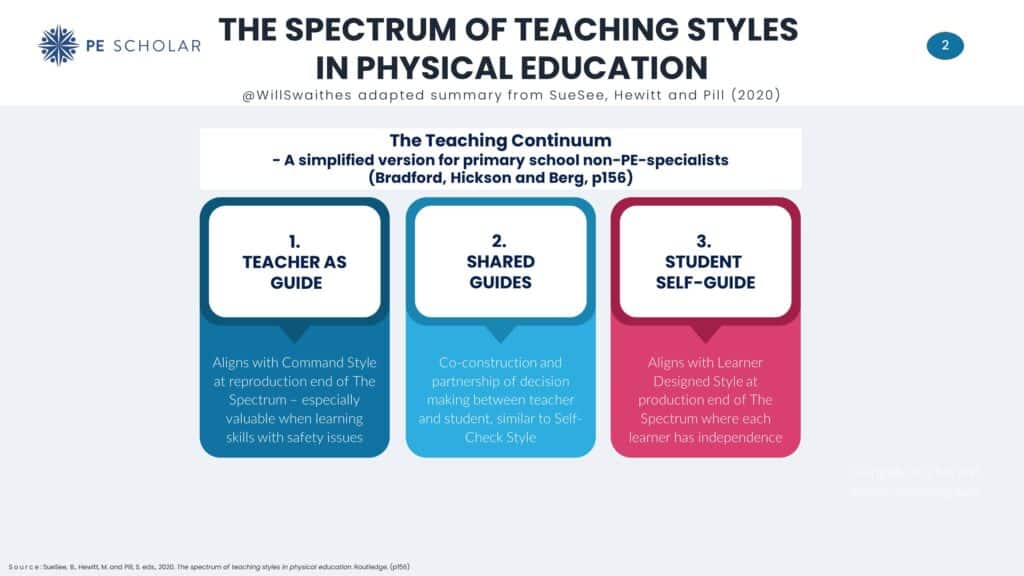
Bradford, Hickson and Berg propose a modified version of The Spectrum in Chapter 14 to help simplify for primary (elementary) school generalists as a foundational framework to help build success amongst the non-specialist in PE. This was considered especially helpful given the pressures placed on languages and mathematics as well as the challenges of transitioning between subject areas and locations (e.g. classroom, hall and field). Again, this chapter reinforces the need for variety i.e. a non-versus approach to pedagogical approaches (p156). Teachers should use several different styles during a single lesson to best meet the needs of students and their learning needs.
The Teaching Continuum that was created has three general styles for teaching:
- Teacher as a Guide – especially valuable when learning skills with safety issues such as a forward roll in gymnastics, this aligns to ‘Command Style’ at the reproduction end of the spectrum
- Shared Guides – a partnership between teacher and student when it comes to decision making to co-construct during aspects of the lesson, for example the creation of a gymnastics sequence with all the characteristics of Self-Check Style
- Student Self-Guide – providing opportunities for students to explore, discover and create where each learner has independence and freedom similar to the Learner Designed Style end of The Spectrum (p157). For example the selection of music to create a dance routine that is subsequently peer assessed. The teachers role is to circulate, encourage and support learning.
Future considerations on The Spectrum
Previous challenges aimed at The Spectrum due to a lack of research into their use in practice along with potential validity and reliability issues have subsequently been explored via ‘canopy designs, the inventory, the model illustration and interrogating other teaching models using The Spectrum’ (p166) in Chapter 15.
The importance of considering the learners in conjunction with the intended learning outcome is reinforced when teachers make pedagogical decisions to select the most appropriate Teaching Style. In fact, it is suggested that the learner is placed at the centre as illustrated in figure 15.3 on page 173 which has been reproduced below with the explicit addition of health and safety considerations as a part of the teacher decision making process:
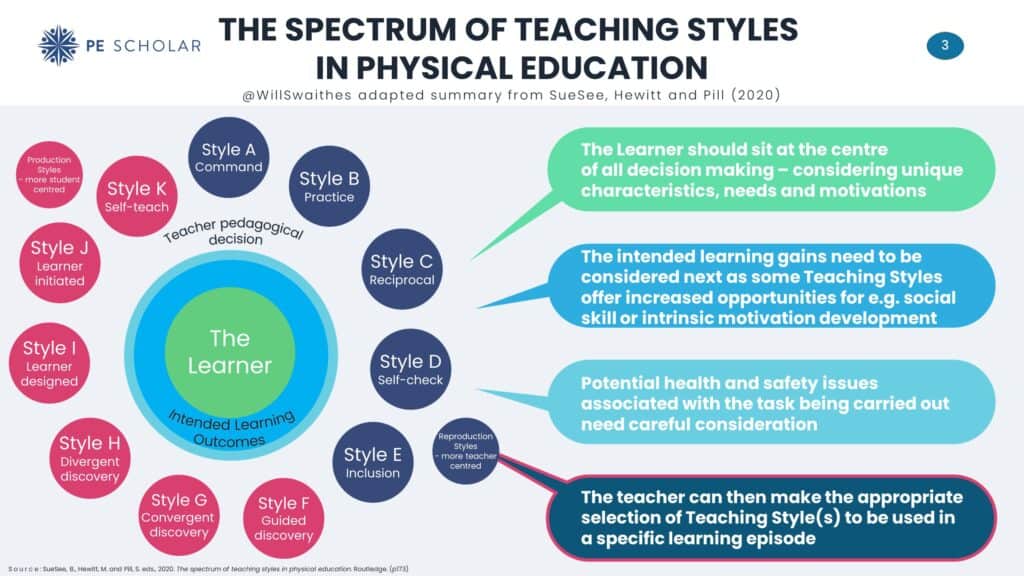
Take Aways
This refreshed and contemporary update has encouraged me to revisit the spectrum of teaching styles and bring to the forefront of my mind the following take aways:
- Match the style to the circumstance – have you considered the needs and motivations of your students or the specific learning gains you want them to reach?
- Interrogate your choice – What learning are you trying to bring about and why will this approach be most effective (‘A-F’ or ‘teacher as a guide, shared guides, pupil as a guide’)?
- Practice to develop your expertise so that you can be an effective practitioner throughout the spectrum.
If you want to read more, I highly recommend downloading the free e-book created by Mosston and Ashworth and available here.
Other book reviews
Here is a list of other book reviews you might want to check out:
Reviews by topic
Health and wellbeing
Happiness Factories: A success-driven approach to holistic Physical Education (podcast)
Time to RISE Up: Supporting Students’ Mental Health in Schools
Physical Education Pedagogies for Health
Inclusion and social justice
Inclusive PE for SEND Children and podcast
Teaching Disabled Children in Physical Education
Pedagogies of Social Justice in Physical Education and Youth Sport
Pedagogy
Applying Models-based Practice in Physical Education
Perspectives on Game-Based Coaching
The Future of Teaching and the Myths That Hold it Back
Meaningful PE – an approach for teaching and learning
Threshold Concepts in Physical Education
The Spectrum of Teaching Styles in PE podcast
Reading lists
Also, don’t forget to take a look at these books published by Scholarly – indispensable additions to every PE teacher’s bookshelf.


[…] The Spectrum of Teaching Styles in Physical Education […]
[…] The Spectrum of Teaching Styles in Physical Education and podcast […]
[…] The Spectrum of Teaching Styles in Physical Education and podcast […]
[…] The Spectrum of Teaching Styles in Physical Education and podcast […]
[…] The Spectrum of Teaching Styles in Physical Education and podcast […]